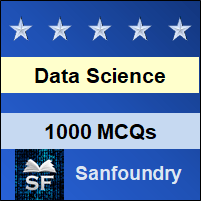
Data Science Multiple Choice Questions Highlights
- 1000+ Multiple Choice Questions & Answers (MCQs) in Data Science with a detailed explanation of every question.- These MCQs cover theoretical concepts, true-false(T/F) statements, fill-in-the-blanks and match the following style statements.
- These MCQs also cover numericals as well as diagram oriented MCQs.
- These MCQs are organized chapterwise and each Chapter is futher organized topicwise.
- Every MCQ set focuses on a specific topic of a given Chapter in Data Science Subject.
Who should Practice Data Science MCQs?
– Students who are preparing for college tests and exams such as mid-term tests and semester tests on Data Science.- Students who are preparing for Online/Offline Tests/Contests in Data Science.
– Students who wish to sharpen their knowledge of Data Science Subject.
- Anyone preparing for Aptitude test in Data Science.
- Anyone preparing for interviews (campus/off-campus interviews, walk-in interview and company interviews).
- Anyone preparing for entrance examinations and other competitive examinations.
- All - Experienced, Freshers and College / School Students.
Data Science Chapters
Here's the list of chapters on the "Data Science" subject covering 100+ topics. You can practice the MCQs chapter by chapter starting from the 1st chapter or you can jump to any chapter of your choice.- Data Science Basics and Data Scientist Toolbox
- Data Analysis with Python
- Getting Data
- Data Analysis and Research
- Statistical Inference and Regression Models
- Machine Learning
- Developing Data Products and Working with NumPy
1. Data Science Basics and Data Scientist Toolbox
The section contains multiple choice questions and answers on basics of data sciences and toolbox, workflow of CLI and git, big data analysis and experimental design.
|
|
|
2. Data Analysis with Python
The section contains questions and answers on pandas, time deltas, python plotting, data structures and computational tools.
|
|
|
3. Getting Data
The section contains MCQs on raw data, processed data, tidy data, web reading, API, data summarization and merging, regular expressions and text variables.
|
|
|
4. Data Analysis and Research
The section contains multiple choice questions and answers on graphical devices and plotting systems, basics of reproducible research, clustering, exploratory graphs and basics of literate statistical programming.
5. Statistical Inference and Regression Models
The section contains questions and answers on probability and statistics, basics of statistical inference, regression models, distributions and likelihood, binary and count outcomes and residual variations.
6. Machine Learning
The section contains MCQs on caret, prediction with motivation, regression and model and cross validation.
|
|
|
7. Developing Data Products and Working with NumPy
The section contains multiple choice questions and answers on shiny, slidify, googleVis and numPy.
|
|
|
Wish you the best in your endeavor to learn and master Data Science!
